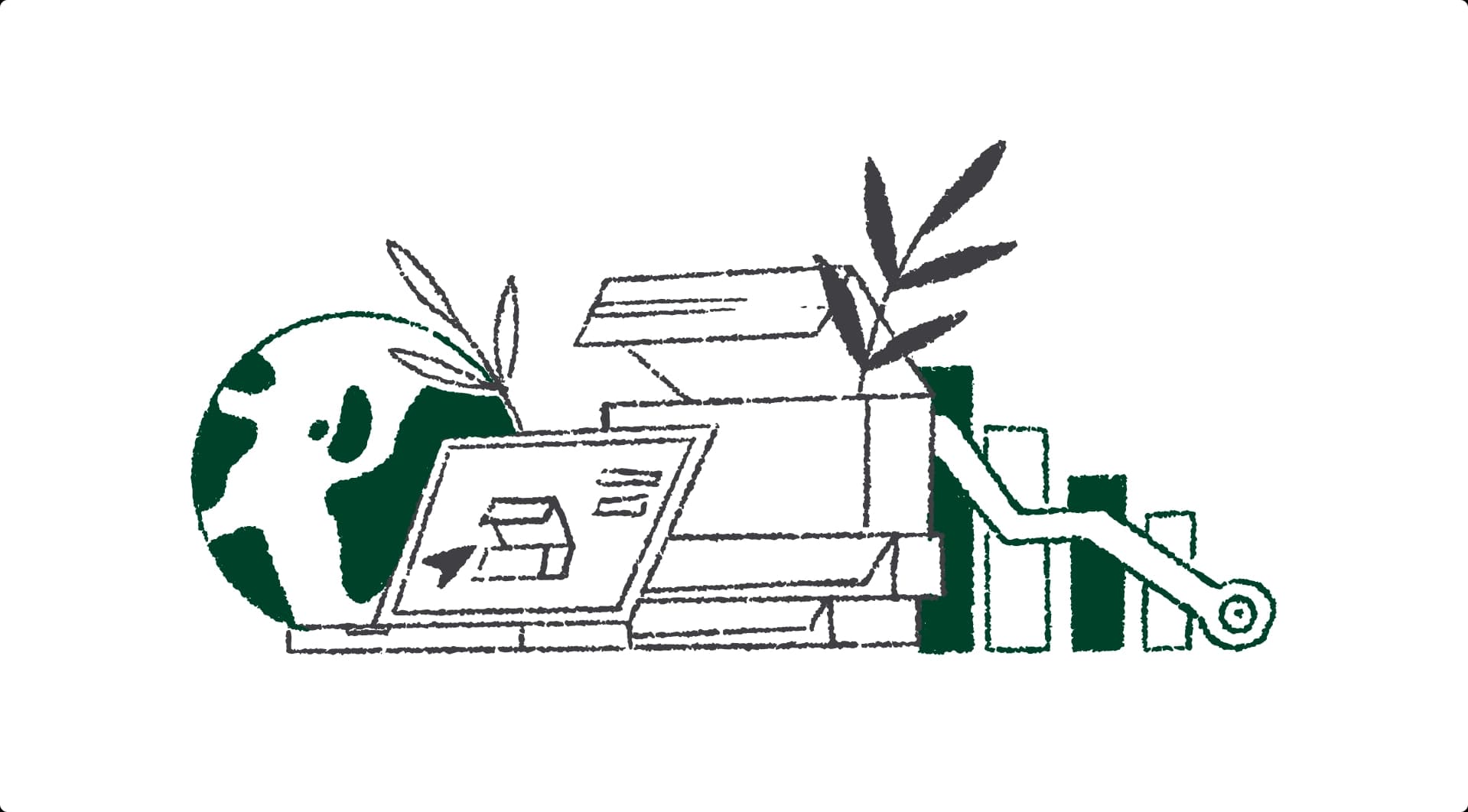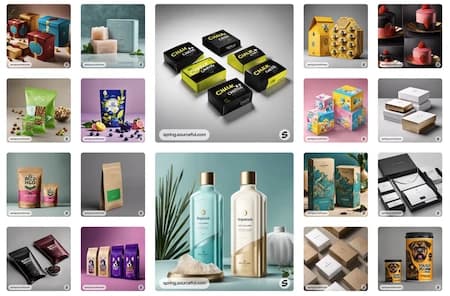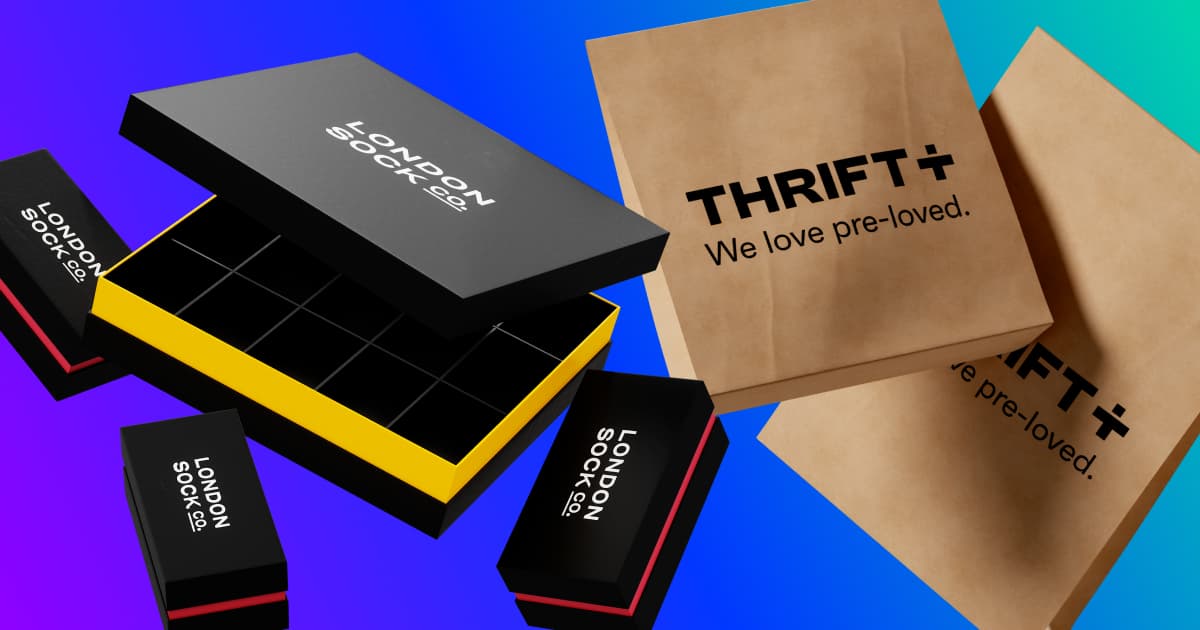Blog PostWhat is sustainable packaging? (with examples)
- Sustainability
- Materials
- Design
Cameron MacinnesMarch 23, 2023 - 10 min read

You may have heard the term “sustainable packaging” and thought about recycling. And you’d be right. Recycling does play a key role in reducing packaging waste. But did you know that there are other ways to make your packaging more sustainable, from changing the materials you use to setting up packaging return schemes?
Here at Sourceful, we’re passionate about packaging with a lower environmental impact than conventional packaging. So, we’ve put together a list of nine common ways to make packaging more sustainable, along with information about how you can get started today.
What is sustainable packaging?
Sustainable packaging is any packaging that’s designed to have the least impact on the environment. And as a business, there are a lot of ways you can make your packaging sustainable. Here are just a few:
- Switch to recycled materials. This will help reduce the demand for virgin materials that often have a higher carbon footprint.
- Switch to recyclable materials. If possible, make sure these are kerbside recyclable — your customers will thank you.
- Design for recycling. We helped ZOE reduce their footprint by 66% by redesigning their rigid box that didn’t use the magnets that previously prevented them from being recycled.
- Reduce wasted space. IKEA famously eliminated air from the packaging of their Ektorp sofa, reducing packaging size by 50%. This led to 7,477 fewer trucks on the road every year.
- Design for reuse. Considering how your packaging could be used after it’s done delivering your product can keep it out of the waste cycle and can become a part of a larger customer experience.
- Ship via sea freight. Air freight can produce 31x more emissions than sea freight. If your product allows it, and you plan ahead, sea freight can be a big win for your business and the environment.
You may think that shipping via sea freight doesn't play a part in sustainable packaging, but in reality, your entire supply chain is a part of it. And considering every stage of your packaging’s life cycle is the best way to achieve sustainable packaging.
One big misconception is that sustainable packaging always costs more than regular packaging. But time and time again we see this isn’t true. In fact, sustainable packaging can lead to significant cost savings because of lighter materials, more efficient design and cheaper freight. All of this means cost reductions for your business.
Learn more: Sustainable packaging: myth vs. reality
Two final notes on sustainable packaging. First, it’s important to remember that sustainable is a relative term. As Patagonia says, everything has an impact — and packaging is no different. Second, not all packaging that is sold as sustainable actually is. For example, we recently found that compostable packaging has up to 2x the impact on climate change than a virgin plastic bag. Your takeaway: always ask suppliers about their packaging and ask for the data to prove any claims.
Why packaging sustainability is important
Packaging waste is increasing. As recently as 2020, Europeans generated as much as 177.2 kg of packaging waste per person and less than half of that was recycled.
One of the major problems here is that much of this waste is petroleum-based. This includes packaging we’re familiar with, such as yoghurt pots as well as common materials like styrofoam. Because these materials are so durable, they can take hundreds of years to break down. When sent to incineration, which is about half the time in the UK, they release harmful greenhouse gases, such as carbon dioxide and methane, both of which contribute to global warming.
But that’s not the only damage petroleum-based products do. Whether in landfill or floating in the ocean, these materials are also hazardous to human and animal health. They can leach chemicals into the environment, block waterways and also be directly ingested as microplastics.
What is sustainable packaging made of?
Paper and cardboard are two of the most common sustainable packaging materials. This is simply because trees are renewable resources and most paper and cardboard can be recycled into new materials and products. In fact, 80% of cardboard and paper products in the UK are made from recycled material. By choosing recycled materials, you can reduce the demand and pressure on virgin materials, which are finite. And, after use, they can be given a new life instead of heading to landfill.
Whilst most sustainable packaging is made from recyclable materials (including recycled plastics), others are more sustainable in other ways. For example, mycelium — the root-like structure of mushrooms — isn’t easily recycled, but it’s grown rather than manufactured, and it uses agricultural waste that would otherwise be discarded. This results in a much lower carbon footprint than many traditional materials, like virgin plastic.
What is sustainable food packaging?
Sustainable food packaging is a category of sustainable packaging. The aim: reduce the environmental impact of food packaging.
As it is a subset of sustainable packaging, sustainable food packaging involves a lot of similar materials and approaches, like recycled and recyclable materials. Our food packaging sleeves, for example, are made from 100% recyclable carton board. And as a sleeve, it’s easy for consumers to throw them away in the recycling bin. Both material and design make it overall a good example of sustainable food packaging.
What is sustainable design in packaging?
Sustainable design in packaging is the design element of sustainable packaging. In other words, it’s all the considerations that go into designing packaging with the smallest environmental impact.
At Sourceful, we focus on three main areas when it comes to sustainable design: remove, reduce, recycle. Like the magnets in ZOE’s rigid boxes, we’re always looking to remove components that are creating more emissions than needed. We then look at reducing where possible, whether materials, empty space or general, without sacrificing function. Finally, we design to make recycling easy. This may mean fewer components, an easy-to-breakdown design or a carefully chosen mix of materials. All of these parts of our approach fall under sustainable design in packaging.
9 examples of sustainable packaging
1. Recyclable packaging
Recyclable packaging is any packaging material that can be collected and processed to make new products. This reduces the need for virgin materials and helps reduce waste on a global scale.
Plenty of materials are recyclable, including metal cans, certain plastics, glass and wood. And not forgetting paper and card — two of the most easily recyclable materials. All of the paper-based packaging we offer is recyclable, either by the roadside or at a local collection point.
2. FSC-certified packaging
Paper and cardboard are some of the most popular packaging materials. They’re natural and renewable and can easily be recycled after use. But because these come from forests, it’s important to make sure that they’re extracted in a responsible way.
The Forest Stewardship Council (FSC) is a global non-profit organisation that promotes responsible forest management. This helps to protect the local wildlife and communities from the environmental and social impacts of poorly conducted forestry.
The FSC-certified label can tell you whether your paper-based packaging has been responsibly sourced. FSC-certified products often include corrugated cardboard boxes, kraft paper products like paper mailer bags, cards and envelopes.
3. Recycled paper and cardboard packaging
Using recycled paper increases the circularity of packaging. It reduces the consumption of finite resources (such as water and land), cutting down trees and stops materials from being sent to landfill.
The good news is that paper and cardboard are two of the easiest things to recycle. In fact, the UK recycles 80% of its paper and cardboard into new products.
You can find a variety of recycled paper products, including cardboard packaging like book mailers, gift cards and even toilet paper.
4. Recycled plastic packaging
The world produces 141 million tonnes of plastic packaging every year and much of this ends up in landfill or in our oceans. So, using packaging made from recycled plastic keeps it out of the environment and reduces the need for virgin materials.
Recycled plastic can be used in many ways, from cosmetics bottles to recycled mailer bags.
5. Plant-based packaging
Plant-based packaging on a large scale is a relatively new idea but the possibilities are exciting. Plants are a renewable resource, which makes them more sustainable than fossil fuel materials like plastic. What’s more, there are plant-based packaging solutions that use leftover waste from other industries, which reduces the need to source more materials.
A good example of plant-based packaging is sugarcane pulp, which uses plant fibres left over from the sugar processing industry. As it's easy to mould, sugarcane pulp is ideal for making custom inserts which can replace harmful packaging like styrofoam.
6. Edible packaging
Nature is filled with its own edible packaging, like the skin of an apple, for example. Like apple skins, edible packaging can be consumed with the product it’s protecting. Although relatively new, it's proving to be a promising replacement for non-renewable packaging often associated with consumables, such as plastic films and sachets.
Seaweed is a great example of a renewable resource that can package and protect products, and it can be consumed or disposed of naturally after use.
7. Returnable packaging
Returnable packaging is designed to be returned to the manufacturer or distributor after use to then be used again. This saves resources, as fewer virgin materials are needed. It also reduces waste.
Examples include bottles used for cosmetics and packaging envelopes used in deliveries.
8. Reusable packaging
Reusable packaging can be used multiple times before it needs to be replaced or disposed of. When designed for multiple reuses, it reduces the need for new packaging production and virgin materials as well as waste.
Cardboard boxes, plastic bags, metal cans, glass jars and plastic containers are all great examples of packaging that can be used multiple times.
9. Mono-material packaging
Mono-material packaging is made from one type of material. Using a single material requires fewer components during manufacturing and enables easier recycling, especially where plastic is concerned.
Aluminium cans are a great example of mono-material packaging.
Benefits of using more sustainable packaging
When balancing your business priorities with your sustainability goals, you might wonder if switching to more sustainable packaging is really worth it. The answer to this is yes, and you may be surprised to hear that the benefits extend beyond reducing your carbon footprint.
Reduce your costs
When considering the switch to more sustainable packaging, a common worry is whether it will be more expensive than traditional packaging. But actually, more sustainable packaging design can save you money in both the short and long term.
Ikea, for example, reconfigured some of its packaging to make it fit more snugly, which means they could ship more products in one go. This saves them €1.2 million per year in transport costs and has the added environmental benefits of fewer transport emissions and fewer packaging materials used.
Meanwhile, governments around the world are cracking down on packaging waste under new extended producer responsibility laws. For example, the Plastic Packaging Tax that now affects plastic packaging in the UK that contains less than 30% recycled plastic. As costs increase for importers and manufacturers, it's likely they will likely pass on some or all of that cost to brands like yours. Choosing more sustainable packaging will help you avoid these new costs.
Improve your social impact
You may not have realised it, but how sustainable your packaging is can have significant social implications.
The FSC, for example, works with local communities, making sure that they’re involved and positively impacted by their forestry operations. So, if you choose FSC-certified products over non-certified products, your packaging can have a more positive impact on people as well as the planet.
Packaging waste has also become a human health hazard in countries such as Indonesia and Malaysia. To avoid contributing to this serious issue, consider recyclable, returnable or reusable packaging and keep packaging away from human habitats.
Create a positive brand perception
Online searches for sustainable products have increased by 71% in the last five years. This shows that customers now not only value price and quality, but also a brand's environmental impact. And customers aren’t afraid to take their business elsewhere if they find a brand that’s more aligned with their values.
So, switching to more sustainable packaging can help you retain your existing client base as well as attract new fans. This can help you stand out from your competitors as a forward-thinking, climate-conscious brand.
Brands using sustainable packaging
Switching to more sustainable packaging has clear environmental, social and financial benefits. But more sustainable packaging isn’t just for e-commerce businesses. Take the following four brands from different industries that are finding ways to reduce their packaging’s footprint.
Lush cosmetics
Lush is well known in the UK for its natural approach to skincare. Their first choice in making their packaging more sustainable is to use as little of it as possible, which works well for solid products such as soap and shampoo bars. For loose or liquid products, they use recycled materials which can be reused, returned or recycled after use.
Mondi
Mondi, a packaging manufacturer, has helped early-adopter brands like Handl Tyrol switch to mono-material food packaging. This reduces the variety of materials the manufacturer needs to source and makes recycling easier for their customers.
Stella McCartney
The fashion industry doesn’t have a good track record when it comes to sustainability. But Stella McCartney’s brand is changing this narrative, using FSC-certified, recycled, paper packaging to complement its more sustainable clothing ranges and reduce fashion’s environmental impact.
How to switch to more sustainable packaging
If you’re thinking that making the switch to more sustainable packaging sounds like a great idea, you’re in good company. But before you make any big changes, we recommend taking the following steps to help you make the right decision for your business.
1. Consider your product’s needs
The first step is to think about what your product is and what kind of protection it needs. You might find that your product needs a lot less packaging than you’re using.
For example, if you’re shipping soft, non-fragile items, such as clothing, in a mailer box, could you switch to a paper mailer bag? This could save materials and improve your shipping efficiency.
2. Conduct customer research
It can be easier to make the switch to more sustainable packaging when you know what your customers value. You might find that your customers would be happy receiving packaging with minimal artwork, for example, which could save you both money and materials.
Or, they might be willing to participate in return schemes, sending the packaging back to you, or to a third party, when they’ve finished with it. RePack is an example of a packaging return scheme that operates internationally.
You may even find that your customers are willing to pay a little extra for more sustainable packaging, which could help you balance out any upfront costs from by the switchover. Knowing what your customers value can help you make informed decisions about your sustainable packaging design.
3. Make changes to your existing packaging
Did you know that the average delivery box is 40% too big for its contents? As a result, you can end up shipping air in your packaging, which takes up space and means you can transport fewer products in one go. It also means you might need to use additional packaging materials like void fillers so that your product doesn’t move around in transit.
To avoid this, you can resize your packaging to make sure it’s the right size for your product. Then, just like Ikea, you can reduce your carbon footprint as well as your costs.
You can also check to see whether your packaging includes any materials that aren’t essential. For example, if you want to communicate with your customers, instead of including a card you could print a QR code on the box, which they could scan to access the information they need.
Sometimes tweaking what you’re already working with can make a significant difference to your packaging’s sustainability.
4. Work with a reputable company
Joining forces with a dependable company, like Sourceful, offers some noteworthy benefits. Firstly, you’ll be reassured that the materials and processes used to create your packaging are certified to certain standards. Dependable companies also tend to have more resilient supply chains, helping you maintain streamlined, consistent operations.
And by collaborating with reputable experts, you benefit from their experience and industry knowledge. This helps you make design decisions with confidence, ensuring your packaging aligns with both your product’s needs and your brand identity.
Working with a reliable supplier can also simplify your switch to more sustainable packaging. For example, easy-to-use tools, like our online design studio, let you take full control of your packaging design without the need for any special skills. Or, you can always lean on the skills and expertise of a team, such as our in-house designers, to help you create bespoke packaging that delivers.
In short, collaborating with a dependable company means your switch to more sustainable packaging can be seamless and stress-free.
Read more: How to go from normal packaging to sustainable packaging
Make your packaging more sustainable with Sourceful
With global packaging waste building up, there’s never been a better or more crucial time to switch to more sustainable packaging. Brands from a variety of industries are making the commitment to reduce their environmental impact and finding that this can benefit their business in the long run.








